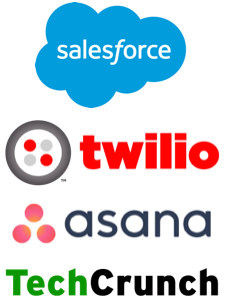Every Single Day, Your Startup's Story Is Losing Customers, Leaving Cash On The Table, And Putting Your Whole Company at Risk.
Here's how get yours right...
When a Y-Combinator startup's traffic wasn't converting into new customers, something had to change...
This startup had launched a new product: a machine-learning tool that could ingest data from any analytics provider and tell you exactly which customers were likely to stop paying and which customers were likely to upgrade.
Despite these benefits, the startup’s website was converting under 2%. The revenue it earned from self-service signups was $0.00. When their sales leader managed to get a potential customer on the phone, he had to explain what the product did, how it worked, and why it was valuable…every single time.
Thanks to the sales manager’s effectiveness, this startup’s monthly revenue was growing, but not enough. The founder and his sales manager knew something had to change if they were going to hit their growth goals and raise their next round.
After This Startup Discovered What To Change,
Month-Over-Month Sales Growth Went Up 166%.
The changes they made were not complicated projects that took 6 months to execute; and even though these changes launched in record time, the results were stellar.
Within a matter of weeks:
- Month-over-month growth in revenue went up 166%
- Self-service customers went from 0% to 20% of new deals
- Potential customers on the phone (who previously had expressed confusion about the product) consistently said they “got it," making sales calls dramatically more effective.
The Main Thing They Changed?
The Language They Used to Describe Their Product...
When the startup in question reached out, I analyzed their website, assessed their sales presentations, researched the competition, and understood the problem.
Nearly every word they used about the product and its features was grandiose, broad, and jargon-laced. Even after reading the site a few times, I still only had a faint sense of what the product did and how it worked.
Worse: It was hard to see why any of the startup’s potential customers would accept the central claims or even care.
The problem this startup had getting customers boiled down to language: the words the team had chosen to position their product were under-selling its value.
Fortunately, this was a good product that could deliver real results. I re-wrote their story to explain the value of the product in precise, clear, and jargon-free language that this startup's potential customers would understand.
The power of language is real. This startup’s 166% improvement in month-over-month growth proves it.
Of Course, Getting Your Language Right is Only One Piece of a Complex Puzzle. Here Are The 3 Most Expensive
Marketing Mistakes Your Startup May Be Making Right Now:
If you want your venture-backed startup to amount to more than an acqui-hire, a fire-sale, a big down-round, or any other sort of disappointing outcome, then you’re going to have to build, launch, market, and sell products that get traction. Then, you'll have to build on that initial traction to create a profitable business model and establish a dominant position in the market.
Of course, this sounds simple, but we all know it sure ain’t easy.
Indeed, the journey is often a lonely one. Along your path, there are many traps to fall into and a handful of insanely expensive mistakes to make. In my career as a product marketing consultant and an in-house product marketer for companies like Salesforce, Twilio, and Asana, I’ve witnessed them all.
Mistake #1: Building & Launching Big New Products and Features Without Clear Positioning, a Compelling Story, and a Solid Distribution Plan

Launching your product before nailing down the story.
There is a unicorn with a big marketing team and a multi-million dollar marketing budget that makes this mistake over and over again.
If you’re a founder with a technical or product background who simply loves to build, these are perfectly understandable mistakes. You’re a builder and a doer, and you’d rather prioritize building things over developing a detailed plan for launching them.
Unfortunately, neglecting to nail down the story and distribution plan is a surefire way to risk your launches falling flat, costing you a ton of money, and hurting your team’s morale.
Sometimes, you may even end up building and launching the wrong products and watching as all that hard work goes up in flames.
So how do you avoid this mistake? Here’s a simple solution, borrowed from Amazon: before your team builds or launches a big new product or feature (or as soon as possible if you’ve already got one in the works), draft the blog post announcing it to the world.
You don’t have to publish this post if you’d rather keep things under wraps. This exercise ensures you understand and communicate in clear terms how customers will get tangible value from your new product or feature. Doing it right dramatically increases the likelihood that you’re building something the people in your market need or want.
But when you write it, avoid simply talking about what the product or feature is and what it does. Instead, write in specific, concrete, powerful terms about what painful problems or compelling needs the new product or feature solves–then how it solves them.
Mistake #2: Publishing a Blog That Doesn’t Move the Needle
There's a Series B SaaS startup that blogs 1-3 times a week and then shares the posts on Facebook, Twitter, and LinkedIn. Often times, they’ll support that activity with some paid promotion on Facebook. I’ve noticed that when they do that, the number of "likes" on Facebook goes up.
Unfortunately, "likes" rarely translate into real engagement or convert into revenue.
The most problematic part? There’s no compelling offer on the blog to get me onto their email list. The primary call to action is something like “Sign up to receive our new posts,” and it’s all the way down at the bottom of the page.
To be fair, this isn’t completely the startup’s fault.

Producing content without clear distribution and list-building strategies
If you follow the conventional wisdom about content marketing and aren’t versed in its art and science, it’s easy to waste tons of money, time, and energy.
Despite the conventional wisdom that "if you build it, they will come," the key to content marketing is not simply producing great content. And it really isn't blogging product updates, company news, partially-baked case studies, and profiles of the people on your team. None of these will attract new customers.
If want your content marketing to inspire customers to bang down your door, the majority of your content has to be precision-targeted to the desires, needs, and challenges faced by the people who need your product the most AND have the authority and/or budget to get it.
On top of that, your content must be:
- Unique and compelling. Like any product you build, your blog and all the content you generate has to be a signal that breaks through the noise if you want it to create a breakthrough for your business.
- Full of actionable advice. The best way to attract the people that need your product is to produce and promote content that helps these people solve their problems and meet their needs.
- In-depth. When a content marketing tool called BuzzSumo analyzed millions of blog posts, they found posts with between 2000-3000 words got dramatically more traffic and shares. Let go of the idea that people don’t read long content. If the blogs you write, videos you produce, and webinars you host are compelling, actionable, and in-depth, people in your market will engage!
- Promoted aggressively. When you create great content without a measurable distribution strategy, you’re playing a Mozart symphony to a half-empty theater. Publishing a blog post and simply sharing it on social media isn’t going to cut it. If you want your team’s hard work on content to generate returns, you need to work on distribution harder than you work on production.
- Focused on growing your email list. No matter who you are or how awesome your product is, your growth will suffer if you neglect to leverage email. Sure, email may someday die. But for now, it remains one of the most powerful, effective, and profitable ways to communicate with your customers and convince them to buy what you’re selling. If you don't have an email marketing initiative going or planned right now, you’re losing out.
Mistake #3: Leaving Tons of Cash On The Table By Neglecting Pricing Strategy

This is what happens when you neglect your pricing strategy.
There are tons of startups with great products and strong customer acquisition efforts that put their success at risk by neglecting to develop a strategy for determining the ideal price of their products.
In fact, MOST startups make this mistake in some form.
How do you know if yours is among them?
Your startup is underinvesting in its pricing if you have neglected to adjust your prices in the last year.
You're neglecting your pricing strategy if you also have:
- pricing grids that fail to make the differences in value between options abundantly clear.
- pricing pages that require me to move a slider to see how much my version of the product will cost.
- pricing tiers with vague names like “Basic,” “Professional," "Premiere" and "Ultimate.”
Like the other two hugely expensive marketing mistakes, this one is also understandable. Pricing strategy can seem like a dark art, and many founders and their teams would rather focus on more approachable activities.
But putting your pricing strategy on the back-burner is a huge mistake.
Indeed, Patrick Campbell, the pricing expert behind the Price Intelligently blog, argues that getting your pricing right is the single biggest lever you can pull to accelerate your revenue and profit growth–more than customer acquisition and retention combined. Given how little attention most founders pay to their pricing strategy, Patrick has a point.
If You Are Making Any of These Mistakes, It's Probably Because You Haven’t Invested In Getting Your Product Marketing Right
If You Are Making Any of These Mistakes, It's Probably Because You Haven’t Invested In Getting Your Product Marketing Right
The notion that “great products sell themselves” is one of the central myths of modern-day startup culture.
So here’s an unspoken truth: every successful technology founder that has created more than a short, bright flash in the pan of history has had to get his or her product marketing right.
Product marketing is more than branding your startup, getting media coverage, optimizing your site for Google, advertising on social media, or running a bunch of growth tests.

Image of someone executing the idealized startup marketing strategy.
Sure, you’ll need those, too.
But great product marketing is about:
- Identifying your target market and the ideal customers within it
- Empathizing with their pains and struggles
- Building a product that addresses these pains and struggles at the right price
- Crafting a compelling story that ties it all together.
So how do you know if your company's product marketing is where it needs to be? Here are four simple questions to ask yourself:
- Can you and everyone on your team explain exactly WHO your product is for, WHY it’s unique, and WHICH problem it solves?
- Has every product, feature, or marketing campaign you’ve launched in the last 6-18 months substantially increased your revenue, adoption, retention, or referrals?
- Have you identified the highest-leverage distribution channels at your disposal?
- Does your pricing reflect the concrete value your product delivers to your customers?
If you answer "no" to any of these questions, or if what you come up with is murky, you face the risk that your startup will eventually fail.
The solution I’m going to suggest can reduce these risks and dramatically increase the probability that your startup, your product, and your vision achieve the potential you know they have.
Here’s The KEY To Launching The Right New Products And Features, Creating Content That Grows Your Business, And Pricing Everything For Maximum Profits
The key is to attack a big, profitable niche you can dominate.
When you’re a startup, even when you have a few hundred people or more, you simply don’t have the luxury of a broad focus. Sure, companies like Salesforce, Amazon, Facebook, or Google can afford to chase a wide variety of markets with a wide array of products.
While even these companies (with billions of dollars and thousands of employees to throw at the challenge) don’t often succeed when they launch products too far outside their core, you definitely don’t have resources like theirs.
But what you do have is the capacity for focus, precision, and speed. Attacking a profitable niche you can dominate is perhaps the single best way to tap into those natural advantages and unlock massive returns.
Indeed, when you identify and attack a profitable niche that you can dominate, the critical things fall into place. With a niche you can dominate in your startup’s crosshairs, your entire company will be able to focus like a laser-beam on a single, specific target.
As a result, you will be positioned to:
- Do a far better job telling the story of the product you already have
- Prioritize the highest-impact products and features to build or improve
- Create a website and a marketing and sales process that converts traffic into customers like crazy
- Generate and promote compelling, precisely-targeted content that actually moves the needle in your business
- Find and develop the most profitable distribution channels
- Discover the prices that reflect the true value of your product, and charge them safely
- Identify the right events, publications, and people to go after for announcements, roadshows, and other awareness-building activities
- Figure out precisely which companies and people to target with your sales efforts
And when your company does all of those things well, great success is the result.
But if attacking a niche confers so many advantages, why do so many venture-backed startups go after broad markets, rather than specific, targeted ones? Let's investigate:
3 Reasons Startups Resist Attacking A Niche
(And Why This Resistance Is Misguided)
From my experiences working directly with founders of ambitious startups I’ve found that the resistance to attacking a niche falls into three main camps:
- Concerns About A Pigeonhole. The first and most common are the founders who believe that targeting a niche forces them into a box, constraining their startup’s potential rather than unleashing it. These founders are worried that if they focus their product development and marketing efforts on a niche, they cut off the possibility of mega-growth and a big exit.
- Distaste For Marketing And Sales. The second batch have a sense that their startup needs a tighter focus, but are somewhat uncomfortable with marketing and sales. These founders tend to avoid learning about these subjects or getting their hands dirty with them.
- Don't Want To Rock The Ship. The third have half-bought into the notion that a tighter focus is the right move, but worry that it means adjusting the direction of the whole ship. And (especially when their startups are far along in their trajectory), turning the ship even a little bit can feel like a “bet-the-company” decision.
If you fall into #1, and worry that a niche confines you too much, consider the historical trajectories of Facebook, Amazon, and Salesforce–each of which focused intensely on dominating a niche before expanding into the multibillion-dollar juggernauts they are today–and you will discover that your fears are unfounded.
If #2 sounds like you, I totally get it. Unlike building products and hiring teams, marketing and sales can feel a bit touchy-feely and even a bit like voodoo at times. It doesn’t have to be that way. There is a systematic, measurable way to identify and attack the right niche without being “sales-y” at all.
If you’re in #3: you’re right. Adjusting the direction of your fast-moving ship CAN be risky, especially if you’re fairly far along. Fortunately, there is a path you can follow to dramatically reduce this risk and ensure the niche you choose to attack is the right one.
And for everyone resisting a niche: Surely, focusing your company in a clear, well-defined direction is not as risky as failing to do so, crashing into the iceberg of weak product marketing, and sinking your entire startup to the bottom. Yes?
Yes.
Ready To Nail Down Your Product Marketing And
Position Your Startup For Sustainable Growth?
When it comes to determining which activities will move the needle rapidly for your startup, there's a huge number of things you COULD do, and tons of conflicting advice about which ones you should. But based on almost 100 years of marketing and sales wisdom, nothing is more important that nailing down your fundamentals.
This thread of marketing wisdom goes back to Claude Hopkins in the 1920's and David Ogilvy in the 50's and 60's. It extends to Geoffrey Moore and Clay Christensen in the 90's and Steve Blank in the 00's: building a great product and supporting it with great marketing comes down to focusing on a target niche and articulating your value to that niche in precise, compelling terms.
When you do those two things right, you position your startup for sustainable, profitable growth.
Unfortunately, identifying the right niche, nailing down the fundamentals of your story, and building a clear roadmap to capitalize on it falls into the "important but not urgent" category. These activities are easy to lose in the hustle and bustle of startup life.
But I'm here to help. I offer a half-day workshop for startups with great products who need to get their product marketing right.
During this workshop (conducted in person or on Google Hangouts), I'll sit down with you and key members of your team a half-day and help you clearly define where you hope to go, how long it’s likely to take to get you there, how much budget you should expect to use, and the risks that might interfere with your success.
After that session, I will take what we’ve learned together and write a clear and concise 5-8 page roadmap that will help you solve the product marketing and growth challenges you face as effectively, efficiently, and definitively as possible.
This roadmap will include:
- A clear path to overcoming the obstacles to your sustainable growth
- A set of your 3-5 most likely "quick wins."
- A draft of your revised positioning and core messages
- 2-3 headlines to test on your homepage and product page
- A 90-day growth plan, including potential channels and target conversion rates.
- Recommendations for new sales processes and software tools that will dramatically accelerate your marketing and sales execution.
The half-day workshop and roadmap starts at $2,499.
I've designed and priced the worskhop so it delivers 5-10x the investment you put in. If it doesn't at least add 2x the value, I'll refund 100% of the cost.
But Don’t Just Take My Word For It. Here It Is,
Straight From A Handful Of Clients:
Three big things happened after Dan re-did our site: 1) Our sales are way up. Now 166% month over month growth. 2) 1 in 5 customers are purchasing our product without ever speaking to a sales person. This did not happen before Dan's revamp. 3) We receive quite a bit of feedback on demo calls where people say ‘I’ve read the site and I get it.’ This also never happened prior to Dan's revamp.
 Zac Auger
Zac Auger
Head Of Sales, Framed.io
We knew we had a compelling product (people who used the product loved it), but our funnel was not converting. Dan came in and understood our business really quickly. In the first conversation, he just "got it" in a way that most consultants don't.
In the course of working with Dan, we increased sales by 150% , which allowed us to start using paid acquisition channels that were previously not profitable. This was a BIG win, and we continue to use the building blocks that Dan created for us.
But I also loved to see his process.
Rather than jump to solutions or conclusions, he started with first principles: talking to the users–current, past, churned, abandoned carts–you name it. He really knows what questions to ask to really get insight into why people are deciding to buy or not buy the product. In a 15 minute call, Dan was able to get through 10+ meaty questions, and get 2-3 pages worth of really valuable insights.
He'll very quickly understand your users as well as or better than anyone on your team.
 Gautam Tambay
Gautam Tambay
Co-Founder, Springboard
In a single, short phone call, Dan gave us three actionable ideas that we could start working on immediately. I learned how to ask customer discovery questions and then pitch a solution that addresses the questions and pain points raised. I learned the importance of creating resource pages on our site, packing them with remarkable content, and including a prominent opt-in. And I learned which marketing tools would help us the most, right now.
 Stuart Levinson
Stuart LevinsonCo-Founder, OpenCompany
How To Get Started In 3 Easy Steps...
- Click the red button below
- Fill out the short form that appears.
- I'll follow up in a few minutes to schedule a free 20-minute consultation.
Product Marketing Workshop & Roadmap For Growth
A half-day workshop and a roadmap for 3 months of marketing & growth activities
This is a path to achieving sustainable growth, based on an in-depth dive into your startup with you and key members of your team.
2 weeks after this half-day session, I'll deliver clear and concise written report that includes:
- A clear path to overcoming the obstacles to your sustainable growth
- A set of your 3-5 most likely "quick wins."
- A 90-day customer acquisition plan, including potential channels and target conversion rates.
- Recommendation for new processes and tools that will improve your marketing and sales execution.
Here’s My Promise To You
If you buy the Product Marketing Workshop & Roadmap For Growth, and you don't get value, I’ll refund 100% of your money.
I’m willing to make this guarantee because I’m confident that the insights you get will be worth dramatically more than the time and money it took you to get them.
So again: if you're not happy with the roadmap and you'll get on the phone to tell me why not, I'll refund 100% of your investment.
Every Day You Spend Without Great Product Marketing, You Lose Customers, Market Share, And Cash.
Now Is The Time To Get Yours Right...
A lot of founders and their teams like to tell themselves that they already have the solutions to all their own marketing problems, and don’t need outside help to show them the way.
But if this were true, it’s worth asking yourself why you haven’t done it yet.
Why, for all the effort and energy you and your team have put into developing your product, haven’t you discovered the ideal market or segments to attack? Why do your launches keep falling short of their potential? Why do you keep producing content that isn’t delivering returns? And why have you invested so few resources in your pricing and packaging?
The fact is that great product marketing doesn’t come easy.
Unfortunately, the longer you go without clearly-articulated positioning, a strong message, a powerful story, high-impact content, and a strategy for getting all of it in front of exactly the right niche, the more opportunity, market share, and money slips through the cracks.
And if this happens for too long, and you neglect to invest in product marketing that reliably delivers returns, the more your whole startup–everything you’ve built, all that money you’ve raised, all the sweat and tears you’ve put into your work–is at risk.
It’s time you get your product marketing right..
Still have questions? I have (some) answers!
So, Who Is This Dan Kaplan Guy, Anyway?
That's me on the right.
I started my career as a long-form magazine journalist while still in college, getting paid good money to write 3,500-10,000 word stories on some pretty nifty things. I was busy dreaming of The New Yorker when I realized that the business models supporting the kind of writing I loved to create were facing extinction.
During my senior year (2005), I decided that technology would be my future, and started a company with a friend from the engineering school. Our original vision involved developing a basic artificial intelligence that would help knowledge workers overcome email overload.

We pivoted away from the email problem when it became clear we were in over our heads, and built a competitor to StumbleUpon instead. We got that product to about 50,000 users, but not much further before we failed.
After bouncing back, I re-discovered my voice in technology product marketing. I got my first product marketing job at Salesforce, then went on to Twilio and then Asana.
I scored my first big win at Twilio, when I led a project to overhaul the website’s SEO and increased traffic more than 30% in two months. I scored another win when a guest post I wrote for TechCrunch drove over 100 new leads to Twilio's sales team.
But soon after that, just when I was gearing up to pitch a detailed go-to-market strategy to the CEO and product team with the VP of Marketing’s support, the VP got an amazing offer from another company and left. He had been my champion and was about to promote me. Without him behind me, my far-reaching proposal got shelved.
When the co-founder of Asana reached out looking to poach me after reading a TechCrunch column I’d written about his company, I took the opportunity. My first win there came quickly, but after failing to communicate with my boss, I ended up leaving after 11 months.
After a number of conversations with startup founders and marketers, I concluded that great product marketing was both essential and seriously lacking among technology startups. I decided to maximize my impact by focusing on consulting and have been working on my business and writing columns for TechCrunch ever since.
Sure, But How Can We Be Sure Dan Kaplan Knows What He’s Talking About?

In my time inside two well-funded SaaS startups and even more since I’ve been consulting, I’ve seen first hand the unfortunate things that happen when founders and their teams make or all of the expensive product marketing mistakes I described above.
The startups I’ve helped since becoming a product marketing consultant have seen sales improvements of 150% and more within a matter of months. Meanwhile, the essays on the future of technology that I write for TechCrunch get shared by thousands of people and consistently rank in the top 10 for traffic on TechCrunch the week they are published.
And unlike other startup marketers or marketing agencies who focus on single tactics (like SEO, paid acquisition, lead-generation, content production, or conversion rate optimization), I help startup founders and their teams systematically develop their strongest positioning, find the biggest strategic levers they can pull on for growth RIGHT NOW, and develop detailed plans to capitalize on them.
Ok, But Don’t I Need To Have This Expertise In House?
Stop right now and think of the world’s most effective startup product marketers. I can think of a total of five. Two of them run startups, and the other three charge $80,000-120,000 for a single half-day seminar.
Trying to find someone who can move the needle as much as it needs to move can be an exhausting, expensive, and occasionally fruitless process for a lot of founders and their teams.
But more than that: getting your product marketing right is a foundational building block: once you've figured out your product marketing strategy, the rest is execution. If you're struggling to build that foundation, an outside perspective–unbiased, free of the influence of internal politics, and fully focused on the task–can be exactly the thing your startup needs.
But All Of This Sounds Like A Big Investment Of Time. Why Should I Prioritize Improving My Product Marketing RIGHT NOW?
What would it mean for your startup if:
- Every new product you launched added tens of thousands, hundreds of thousands, or even millions of dollars to your revenue?
- Your website and all the content you produced reliably brought in more qualified traffic, leads, and sales?
- You could safely raise your prices by 10-25% or more?
It doesn’t matter if you’re taking your startup from promising product to initial traction, from traction to growth, or from growth across the chasm to the mainstream. If you invest in getting your product marketing right, you dramatically increase the probability of creating something that lasts.